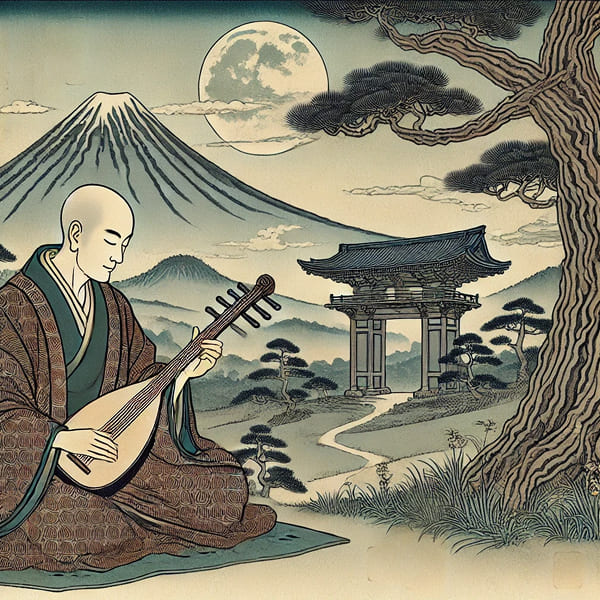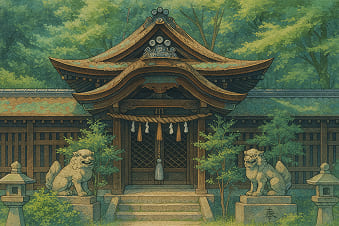Semimaru: The Blind Poet and Spirit of Japanese Art and Spirituality

What if the most profound music came not from sight—but from solitude and sorrow?
High in the misty mountains of Japan, the faint sound of a traditional Japanese lute called the biwa drifts through the trees. It is said to be the echo of Semimaru—a legendary blind musician and poet, exiled from the court but elevated in spirit. Neither fully myth nor confirmed history, his story bridges the sacred and the sorrowful.
In this article, we journey into the world of Semimaru, a figure who turned isolation into inspiration. From his mysterious origins and haunting poetry to his transformation into a patron deity of the arts, discover how one man’s exile became a symbol of artistic enlightenment, resilience, and the quiet power of the human soul.
Origins in Mystery and Exile on Mount Ōsaka
According to legend, Semimaru was either the son of Emperor Daigo or a nobleman named Minamoto no Tōru. Born blind, he was deemed an ill omen and was banished from the imperial court. He took refuge on Mount Ōsaka, a borderland between the capital and the outer world, where he built a modest hermitage.
Historical Context: In ancient Japan, physical disabilities were often seen as signs of divine displeasure or karmic retribution. The exile of Semimaru reflects the harsh social attitudes of the Heian period (794-1185).
There, Semimaru embraced a life of solitude, dedicating himself to playing the biwa. His music, filled with melancholy and quiet strength, reflected his inner vision and emotional depth, qualities that elevated him beyond mere exile.
The Biwa: Instrument of the Soul
The biwa, a four-stringed lute, was considered the instrument of storytellers and wandering monks. Its haunting tones could evoke:
- Sorrow - for lost loves and broken dreams
- Transcendence - lifting the spirit beyond earthly concerns
- Narrative - telling epic tales through music alone
Semimaru’s Poem in the Hyakunin Isshu
One of Semimaru's most enduring contributions is his inclusion in the revered anthology Hyakunin Isshu, which features a poem that captures the essence of impermanence and parting, core themes in Japanese aesthetics:
これやこの 行くも帰るも別れては
知るも知らぬも 逢坂の関
(This way, whether going or returning,
We part, whether we know each other or not,
At the Ōsaka barrier)
The poem's backdrop—the Ōsaka Barrier—symbolizes the spiritual and physical boundary between worlds, reinforcing Semimaru's liminal role in Japanese thought.
A small break — a little side note
This short video offers a clear and charming explanation of his Hyakunin Isshu verse—capturing the bittersweet beauty of parting at the Ōsaka Barrier.
Watch to discover the meaning behind one of Japan’s most poetic expressions of impermanence.
Understanding Mono no Aware
This poem perfectly embodies mono no aware(物の哀れ)—a classical Japanese concept often translated as “the pathos of things” or “a bittersweet awareness of impermanence.”
| Concept | Meaning | Example in Poem |
|---|---|---|
| Impermanence | Nothing lasts forever | "going or returning" |
| Transience | Moments pass quickly | Meeting strangers briefly |
| Melancholy | Gentle sadness | Parting without knowing each other |
Although not commonly used in everyday conversation today, mono no aware was a central aesthetic sensibility in classical Japanese literature and culture. It reflects an emotional response to the fleeting nature of life—a quiet, poignant recognition that all things, beautiful or sad, are destined to change and fade.
Noh Theater: The Tragic Beauty of Semimaru and Sakagami
In the classic Noh play Semimaru, the story introduces his fictional sister, Sakagami, a noblewoman who has descended into madness. She appears suddenly at his hermit's hut, disheveled and wandering, seeking meaning in her broken state.
Note: This sibling relationship is unique to the Noh adaptation and does not appear in historical or literary records.
Their short reunion is marked by shared suffering and mutual recognition—between the blind brother and the mad sister—before they part once again. This poignant tale reflects Japanese concepts of mono no aware (the beauty of impermanence), spiritual connection, and the nobility of sorrow.
Visual Elements of Noh Performance
The Noh play Semimaru employs powerful visual symbolism:
- Masks: Representing inner emotional states
- Costumes: Rich fabrics showing former nobility
- Movement: Slow, deliberate gestures conveying deep emotion
- Music: Biwa accompaniment creating atmospheric soundscape
A small break — a little side note
The Noh play Semimaru is still performed today in major schools such as Kanze and Hōshō.
Autumn performances are especially popular.
For international visitors, it offers a rare opportunity to experience the spiritual depth of Japanese culture.
Want to dive deeper into the story and themes of the Noh play Semimaru?
Check out this detailed English overview provided by the-noh.com, a trusted resource on classical Japanese Noh theater:
the-noh.com: Semimaru
Semimaru’s Legacy: From Outcast to Guardian Deity
Over time, Semimaru evolved into a Shinto deity, revered as the patron of music and the arts, as well as a protector of those with visual impairments.
The Semimaru Shrine in Ōtsu City, Shiga Prefecture, remains a pilgrimage site for those seeking artistic success, musical talent, or healing for eye diseases.
This transformation from a cast-off figure into a god reflects a key trait of Japanese spirituality—the sacredness of suffering and the belief that art can transcend hardship.
Modern Pilgrimages to Semimaru Shrine
Today, visitors to Semimaru Shrine include:
- Musicians seeking inspiration and skill
- Artists praying for creative breakthrough
- Those with visual impairments seeking healing
- Students preparing for artistic examinations
- Tourists drawn to the poetic beauty of his story
A small break — a little side note

Semimaru Shrine in Ōtsu, Shiga Prefecture, continues to attract worshippers from the music and performing arts communities. It is well known as a place where music university applicants and performers come to pray to the “god of music.”
Echoes of the Biwa: A Legacy That Still Resonates
Semimaru's legacy reminds us that true vision often comes from within. Though blind, he perceived the world with spiritual clarity, channeling pain into beauty through his music. His story continues to inspire those on their own artistic or spiritual journeys.
"The greatest art often emerges from the deepest suffering, transformed by the alchemy of the human spirit into something transcendent." - Modern interpretation of Semimaru's legacy
Even now, in the quiet forests of Mount Ōsaka, some say the gentle sound of the biwa—Semimaru's soul in strings—still echoes through the mist.